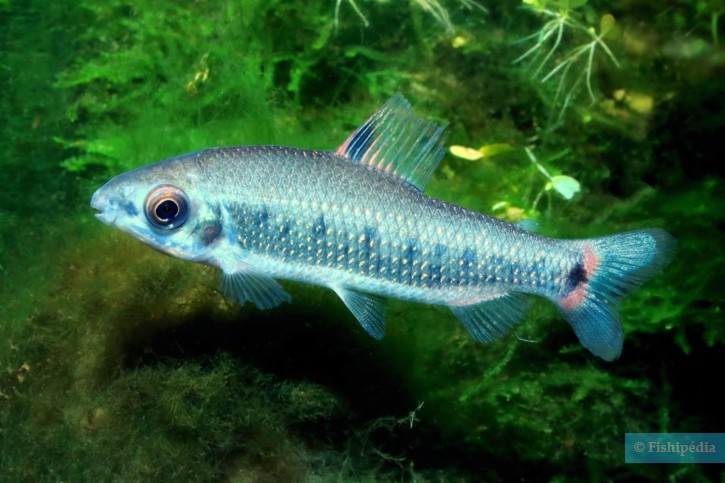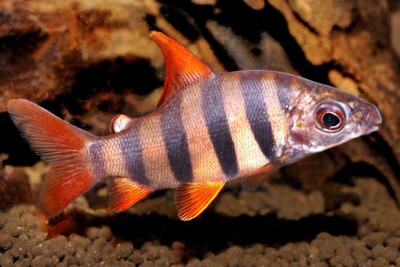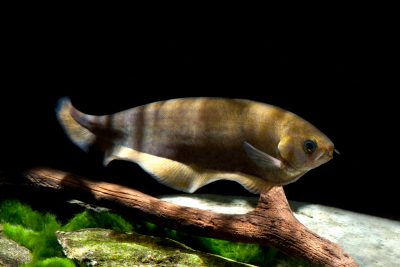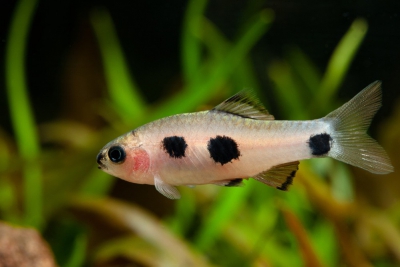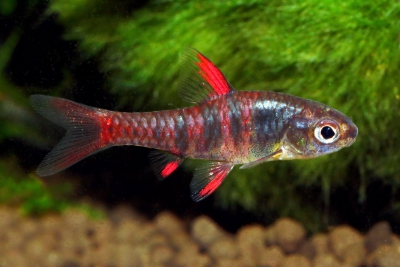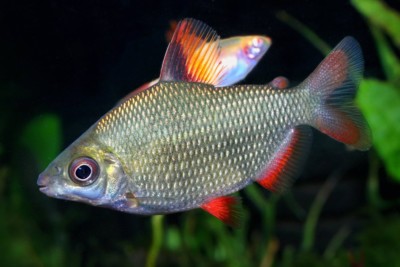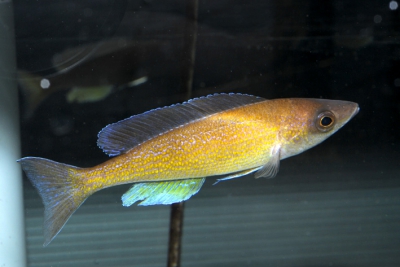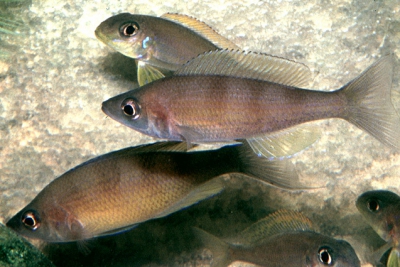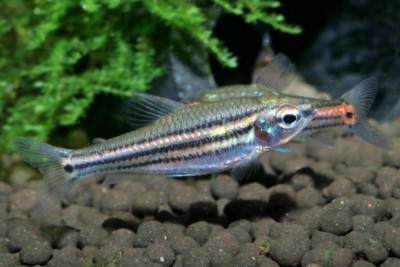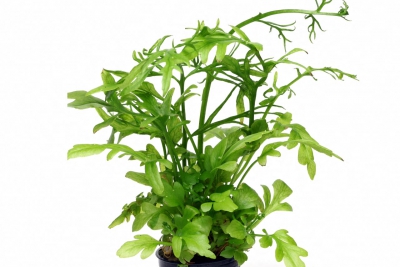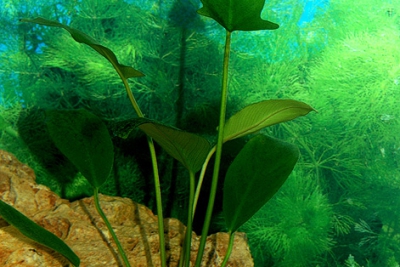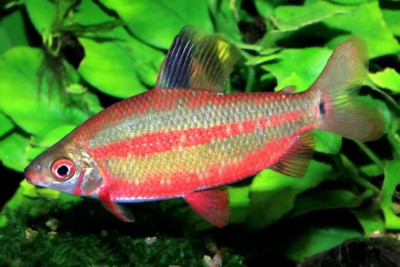dwarf distichodus
| Scientific name | Distichodus decemmaculatus |
|---|---|
| Descriptor | Pellegrin |
| Year of description | 1926 |
| IUCN category (World) | LC |
| Family | Distichodontidae |
| Genus | Distichodus |
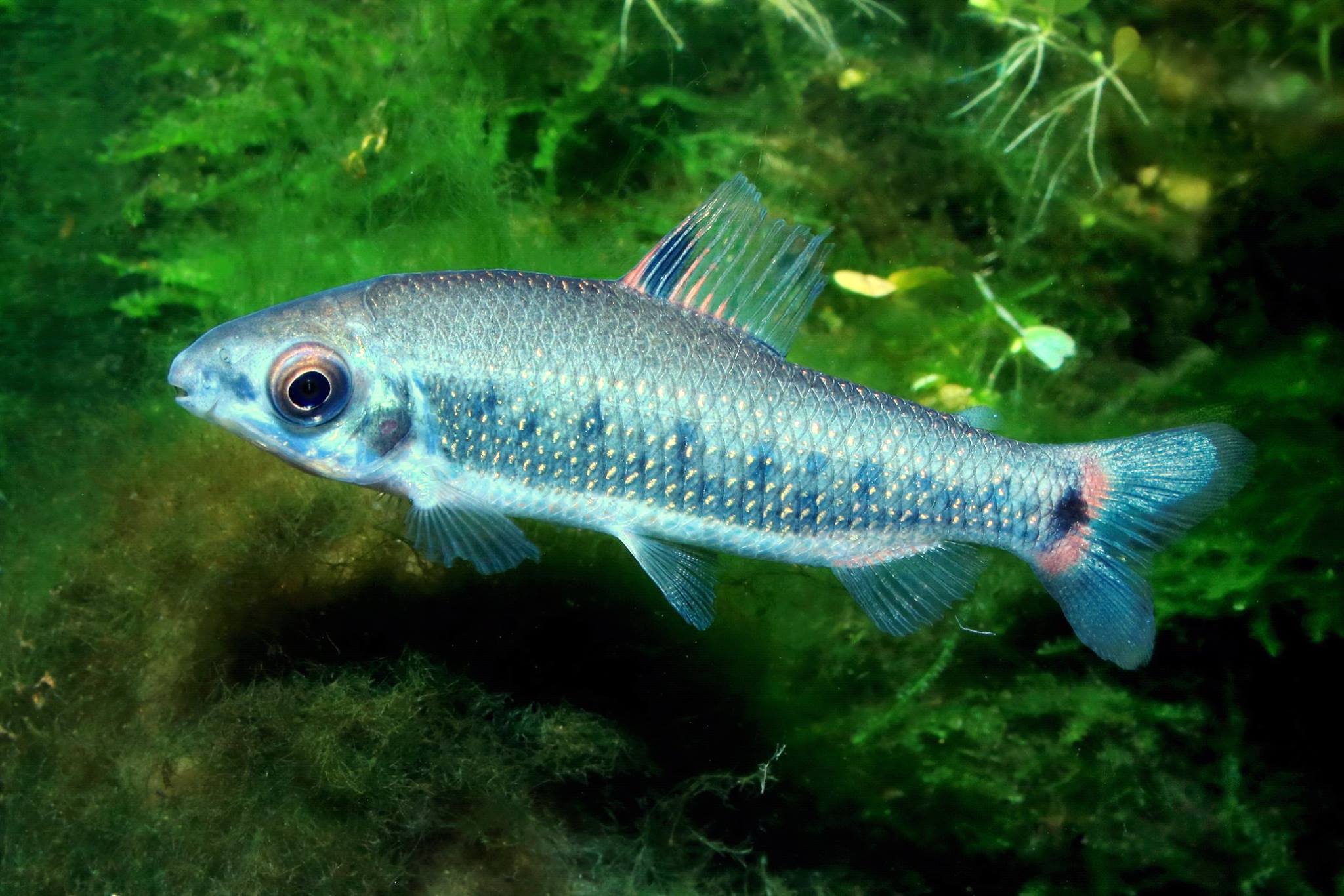

Introduction
The dwarf distichodus is a small tropical fish native to Africa.
Who is it?
Morphology
-
Average size5 cm
-
Maximum size8 cm
-
Longevity8 year
-
ShapeOvoid
-
Average size5 cm
-
Maximum size8 cm
-
Longevity8 year
-
ShapeOvoid
How to recognize This fish ?
The body height is 2.7 to 3.3 times in the standard length.
The dorsal fin is composed of 3 to 4 simple rays followed by 12-15 branched rays. The anal fin has 3 simple rays and 9 to 11 branched rays. The gill rakers of the lower part (ceratobranchial) of the first gill arch are 10 to 12 in number.
There are 38 to 41 scales along the body, 6½ to 7½ above the lateral line and 6½ to 8½ below.
There are two rows of bicuspid teeth on the upper jaw, but only one on the lower jaw.
The overall coloration is olive-brown, with coppery and blue-green iridescence. Each scale on the flanks has a small blue-green pearly spot. There are 7 to 12 small round spots (vertically elongated in young specimens) along the lateral line, the first (faint) behind the operculum, the last (larger) at the base of the caudal fin. There is also sometimes a second irregular row or only a few spots on the lower flanks.
The unpaired fins are salmon or orange. The dorsal fin has a large black spot at the base of the anterior rays and a small red spot at the origin.. The lobes of the caudal fin are slightly darkened. The paired fins are yellowish.
Sexual dimorphism
Dwarf distichodus do not display sexual dimorphism or dichromatism.
Behaviour & Life cycle
-
dietherbivorous and omnivorous with herbivorous tendency
-
Sociabilityliving in shoals
-
territorialNo
-
Way of livingdiurnal
The dwarf distichodus mainly feeds on vegetation, as well as worms and other invertebrates living at the bottom. It can therefore be considered as a phytophagous-dominant omnivore.
Reproduction
-
Reproductionovipare qui pond en eau libre
D. decemmaculatus is an oviparous fish with an unknown reproduction protocol. In a mature female, 1000 to 1550 yellow eggs of about 1 mm in diameter have been counted.
Harmless species
This species does not represent any particular threats to humans when encountered in its natural environment.
Origin and distribution
Geographic distribution & Conservation
D. decemmaculatus is an exclusively Congolese species that seems to be limited to the middle Congo.
This widely distributed species in Central Africa is considered of "Least Concern" according to the IUCN.
Conservation status of populations (IUCN)
What is its habitat?
Natural environment characteristics
-
Temperature23 - 27 °C
-
pH (acidity)6.5 - 7.5
-
gh (hardness)10 - 20
-
FlowSlow and Stagnant
Biotope presentation
D. decemmaculatus frequents the grassy edges of large or medium rivers with slightly acidic water and a temperature of about 25°C. This species, which lives in small schools, only frequents calm areas or very moderate currents.
Species of the same biotope
Main recommendations for fishkeeping
Deontology
In order to preserve wildlife, if you acquire this animal, it must not be released into the wild. See also, the Fishipedia charter.
Fishipedia supports the practice of responsible and environmentally friendly aquarium keeping. We encourage maintenance if it is motivated by a desire to understand the biological functioning of living things and if it is done with respect for animal life.
We believe that aquaristics is an opening to the discovery of aquatic environments, especially freshwater, and that this knowledge is necessary to better protect and respect these environments. Logically, we refute the compulsive purchase of animals that would not find a sufficient and / or adapted place in the host aquarium.
Our recommendationsThese tips apply to adult species from breeding. With regards to water conditions, wild species or close relatives must be kept under the same conditions as in their area of origin.
-
Min volume200 liters
-
Population minnot specified
-
Temperature23 - 27 °C
-
pH (acidity)6.5 - 7.5
CharacteristicsThe characteristics below apply for adult species. They correspond to an average of cases, validated in maintenance condition.
-
Difficulty breedingThe farming difficulty is relative. It depends on experiments already carried out with similar species. First, it takes into consideration the robustness of the species, the ease of recreation of a favorable environment and the general behaviour with the other inhabitants of the aquarium.moderate
-
Robustnesstolerant
-
Behaviourslightly aggressive
-
Availabilityrare
Recommended equipment from our partners
-
Aquarium
-
Filtration
General reminders
It is strongly advised to read the complete dedicated file and to get information on the feedbacks of maintenance of the envisaged animal, this to avoid any potential conflict whose end result is generally the death of the individual (or the other inhabitants). It is important not to overload your aquarium to limit pollution. This will make maintenance easier.
In nature, animals are subject to weather conditions and live in waters with variable characteristics. The recommendations offered by our team for aquarium maintenance are a guidance and cannot be assimilated to scientific datas.
General reminder on maintenance datas
Le démarrage d'un aquarium est une partie primordiale pour l'équilibre et le bien-être des poissons. Lorsque l'on met en eau un aquarium, l'eau passe naturellement par un cycle biologique : le cycle de l'azote. Celui-ci dure environ trois semaines. Tous les 2 jours, nous vous conseillons de tester votre eau jusqu'à ce que le taux de nitrite soit à zéro pendant plusieurs jours d'affilée.
Pour accélérer ce cycle, vous pouvez utiliser un activateur de bactéries comme JBL Denitrol. Cette solution riche en bactéries vivantes et enzymes permet une mise en place rapide du cycle de l'azote. Les poissons peuvent alors être introduits plus rapidement.
Il est important de tester l'eau de son aquarium régulièrement pour maintenir un environnement sain pour les poissons et les autres habitants. Les tests d'eau permettent de mesurer les niveaux de différents paramètres tels que le pH, la dureté totale, ainsi que les taux de nitrates, de nitrites et d'ammoniaque.
Pour réaliser ces tests, vous pouvez utiliser des produits d'analyse spécialisés tels que JBL ProScan qui permet de réaliser un diagnostic de l'eau directement via un smartphone. Il existe également des coffrets de tests plus classiques de bandelettes, comme JBL PROAQUATEST.
En cas d’usage de l’eau du robinet, vous pouvez utiliser un conditionneur d’eau de type Biotopol de JBL pour éliminer les substances nocives comme le chlore, le cuivre, le plomb et le zinc. Les conditionneurs d'eau garantissent une meilleure santé aux poissons et une meilleure croissance des plantes.
Chlorine and chloramine are dangerous for the health of animals. Used to disinfect water, these agents are present in significant quantities in tap water. We recommend using an anti-chlorine agent every time you change the water. In addition to chlorine, treatments and medicines sold for aquarium use sometimes contain dangerous heavy metals in high doses.
Specific needs for the dwarf distichodus
The dwarf distichodus is a species which lives naturally at a temperature between 23 °C and 27 °C. For proper maintenance, the temperature should never exceed the 30°C for long periods. Nitrate levels should remain below 50mg/L. To keep the water clean and unpolluted, plan on changing 20% to 30% of the water volume each month.
The breeding of this species is accessible on condition of being well informed about its needs in aquarium . Any cohabitants must be chosen with care to avoid the loss of animals.
This species is very rare in the aquarium trade. Instead, it is maintained by knowledgeable aquarists who own and breed individuals from wild origin strains. If you want to get this species, we advise you to contact specialized clubs. }Specimens from long time breeding are a bit easier to breed but you have to respect the particular water parameters.
Formal incompatibilities
Cohabitation & Environment
Being a living in shoals fish, it is advisable to install at least 0 individuals in an aquarium of 200 liters minimum. Group maintenance is a prerequisite to ensure their well-being. Lonely individuals tend to quickly become stressed and become especially susceptible to disease. Warning, mixing several species living in the same living area is not recommended if the volume is not significant.
Be careful, this species does not appreciate plants and will end up destroying, uprooting or nibbling them. It will not be possible to make an aquarium planted in its presence.
Tips for feeding
The dwarf distichodus is herbivorous and omnivorous with herbivorous tendency.
This species can eat dry food (flakes, pellets), fresh food and frozen food. To avoid deficiencies, it is recommended to vary the types of food.
You should not overfeed your residents to avoid polluting the water. For most species, it is better to feed a few small portions each day rather than one large meal.
Food recommendations from our partner JBL - Products PRONOVO
-
Granules
-
Flakes
-
Sticks
Reproduction protocol
-
egg-laying protectionNo
Hybridization risks
In general, it is advised not to mix several species of the same genus or different varieties of the same species, to avoid the risks of hybridization.
These animals might interest you
These plants might interest you
Plants play a crucial role in aquariums, both for their ability to filter water by absorbing excess nutrients and for their aesthetic contribution. They provide fish with natural hiding places, can serve as breeding sites, and generally help maintain the overall balance and optimal conditions of the aquarium. The selection presented here includes species from the same regions as the species described on this page, although they do not necessarily come from its exact natural biotope.
To go further
Sources & Contributions
Participation & Validation
The Fishipedia team and specialist contributors are committed to providing high-quality content. However, although the information comes from scientific sources or testimonials from specialists, the cards may contain inaccuracies.

Didier Paugy

Benoit Chartrer
Translation
Translation done with the valuable contribution of our translators, who make this information available to a wider audience. We sincerely thank them for their commitment.
Scientific partners
Species of the same family
Same genus
Species of the same biotope
